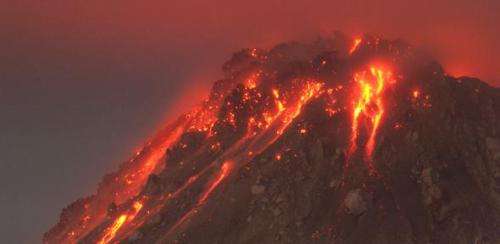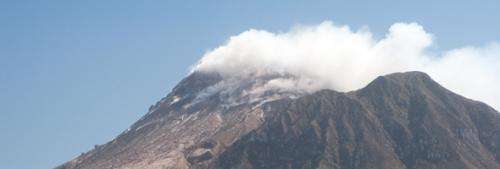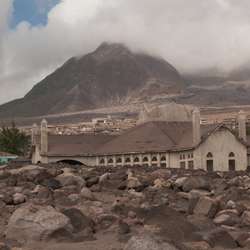And now, the volcano forecast

Scientists are using volcanic gases to understand how volcanoes work, and as the basis of a hazard-warning forecast system.
When the USA's Mount St Helens erupted in 1980, just two months after showing signs of reawakening, its blast was equivalent to 1,600 times the energy of the atomic bomb dropped on Hiroshima. It remains the most economically destructive volcanic event in the USA's history.
When Eyjafjallajӧkull erupted in 2010 in Iceland, the ash cloud it emitted stranded around half of the world's air traffic, with an estimated global economic cost of US $5 billion. Recently, magma has been on the move again, this time under and beyond Iceland's Bárðarbunga volcano.
Volcanoes are the vents through which our planet exhales. Yet, not all volcanoes experience spectacular releases of energy, or even erupt at all: of the 500 or so volcanoes that are currently active worldwide, 20 might be expected to erupt in any one year. But, when volcanoes do erupt, they can cause almost total destruction in the immediate vicinity and the ash clouds they release can affect areas thousands of kilometres away.
Fortunately, the ability to monitor volcanoes has dramatically improved in recent years, thanks in part to the work of scientists like Dr Marie Edmonds in Cambridge's Department of Earth Sciences.
Studying the behaviour of volcanoes such as Soufrière Hills in Montserrat, which caused the displacement of two-thirds of the island's population (over 8,000 people) when it erupted in 1995, Edmonds and colleagues have accumulated huge datasets on everything from the type and quantity of gas belched from volcanoes, to the bulging and deformation of the volcanoes' shape, to the altitude and quantity of ash thrown up into the stratosphere.
"About 600 million people live close enough to an active volcano to have their lives disturbed or threatened, so there's a clear need for hazard assessment," Edmonds said. "We knew that gas monitoring data could be essential for this, but monitoring depended on the use of cumbersome instruments that had to be driven around the crater's edge."

In the early 2000s, with funding from the Natural Environment Research Council (NERC), she and Dr Clive Oppenheimer from the Department of Geography developed a new gas sensor – one that is cheap, miniaturised and can be left long term on the volcano, relaying the data back to the observatory by radio modem. Today, sensors like these are used by scientists worldwide for monitoring volcanoes.
"Previous studies had shown that changes in the emission rate of gases correlated with volcanic activity but, because we have such a long dataset, we began to see another pattern emerging," said Edmonds. "What you see at the volcano surface is really only the end part of the story."
The intense temperatures and pressures deep in the earth find release through fissures and cracks, which carry dissolved gases such as carbon dioxide (CO2), sulphur dioxide (SO2), hydrogen chloride (HCl) and steam up through the mantle to the crust.
As the magma begins its journey to the surface, the pressure lowers and dissolved gases form tiny bubbles, which start to expand. Close to the surface, the expansion can be so great that it fuels an explosive burst of lava, shooting volcanic gases tens of kilometres into the earth's atmosphere.
Because each species of gas dissolves at different pressures, the scientists can measure what is released at the surface and use this to work out the depth at which the gases separated from the magma to form bubbles. "The gases are like messages that tell you how the volcano is 'plumbed' and what shape that plumbing is in," explained Edmonds.
"One intriguing pattern to emerge in Soufrière Hills is that the time series for the magma eruption and that for the SO2 gas eruption are completely unrelated to one another. There have been three big episodes of lava extrusion in the past 15 years and, although HCl flux seems to be a proxy for eruption rate, SO2 emission is uncoupled from what is happening in the eruption. We think the SO2 flux is telling us about something much deeper in the system."

When these results were combined with a study of the rocks spewed from the volcano, Edmonds and colleagues began to piece together an idea of the physics and chemistry happening within.
They believe that a hot magnesium- and iron-rich 'mafic' magma is intruding from depth into the shallower magma chamber where it meets a silica- and crystal-rich 'andesite' magma that forms the main part of the eruption. However, it is the gas-rich mafic magma that Edmonds and colleagues believe triggers and fuels the eruption, and it is this that surface SO2 levels are a proxy for.
"This is far from the traditional view of how a magma chamber works," said Edmonds. "It was thought to be balloon-like but now we think it's vertically protracted, with different types of magma at different levels."
"The surface SO2 is telling us about long-scale processes, of the order of months to years," explained Edmonds. "Even though there may be no evidence of lava at the summit, if SO2 is still outgassing then there's potential for the eruption to resume. We can to an extent use it to forecast a volcanic eruption."
Recently, Edmonds and colleagues joined forces with researchers at other universities to understand how best to monitor volcanoes and earthquakes in two new NERC-funded projects. The £2.8 million Centre for the Observation and Modelling of Earthquakes, Volcanoes and Tectonics (COMET+) programme run by the University of Leeds will provide new understanding of geohazards to underpin national risk capabilities; and the £3.7 million RiftVolc project will create a long-range eruptive forecast for the largely uncharted volcanoes in the East African Rift Valley.
For Soufrière Hills, monitoring is providing a key input to the risk assessments by the UK government's Scientific Advisory Committee for Montserrat, a British Overseas Territory. "All the surface signs indicate the volcanic activity is decaying away but, from the SO2 emissions, the volcano remains active at depth. We think there's a huge magma reservoir – tens of cubic kilometres beneath the island, much bigger than the island itself. We know from looking at older ash deposits on the island that this volcano is capable of much larger eruptions than we have seen in recent years, perhaps even as large as the Mount St Helens blast."
Provided by University of Cambridge




















